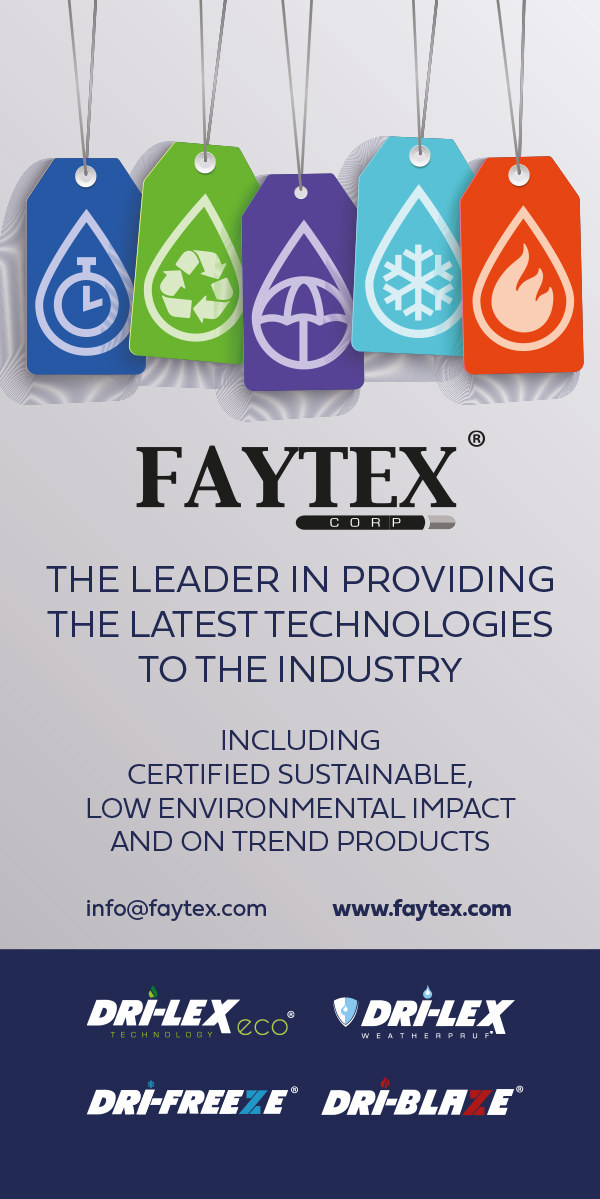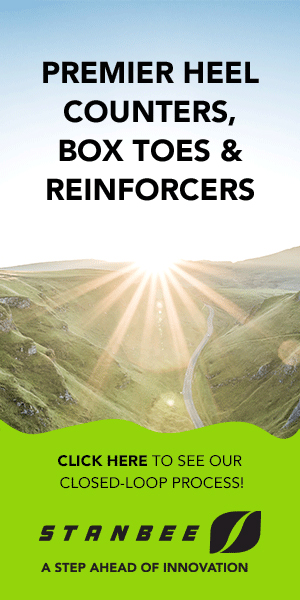A cure for the PFAS problem

Textile finishing specialist (GTT) is taking its PFAS- and water-free Empel textile finishing platform into footwear.
Developer of water repellency solutions Green Theme Technologies (GTT) has said interest is growing in its Empel platform. Its process is free from per- and polyfluoroalkyl substances (PFAS) and does not use water. Instead, it applies the chemicals that help keep materials dry directly onto fibres and uses thermal curing to create a molecular covalent bond between the polymers and the fibres in fabrics. When exposed to heat, molecular bonding and polymerisation occurs, creating long-lasting protection from moisture. Garment brands have already brought Empel-enabled jackets to market, but GTT has told us that the keenest interest it is experiencing at the moment is from footwear brands.
Years of hard work and deep thinking have gone into the technology, prompted by the PFAS debates of 2012. That was the year in which campaign group Greenpeace published a report called ‘Chemistry for any weather’, in which it criticised the ongoing use of PFAS by outdoor brands. Clothing companies soon began to impose restrictions on these traditional durable water repellency (DWR) finishes, based on C8 chemistry. These have chains of eight fluorinated carbon atoms. When the search for alternatives began in earnest, there was much talk about shorter-chain C6-based solutions. The message was that these were more sustainable owing to a faster breakdown in the environment of potentially harmful by-products.
For example, chemicals group Clariant announced in that same year, 2012, that it was investing €8 million in an expansion of production of C6-based fluorochemicals at its Gendorf plant in Germany to help its textile customers “make the switch” from C8.
Bonds that don’t break
“The information on C6 was incorrect,” says the president of business development at GTT, Martin Flora, now. “C6 is no better because it still has carbon and fluorine at its core. Fluorine forms the strongest bonds of any element in the periodic table. If fluorine bonds with carbon, it won’t unbond for thousands of years. That’s why these chemicals don’t break down.”
Other options that have come to market subsequently include non-fluorinated C0 solutions, but these present challenges, too. C0 is a bad name, Mr Flora argues. It has zero fluorine attached, but it still has carbon at the foundation of the polymer chains. These technologies are water-based. And if water-based solutions wash in, they will also wash out. He adds: “The whole of the textile industry is based on the use of water as a solvent for applying chemistry to non-water-soluble fibres. All synthetic fibres are essentially hydrophobic by nature. They can absorb some water, but not enough for a complete covering. It’s like putting a band-aid on a big wound.”
Wider discussion
This is the context in which GTT started its bid to offer a better alternative. Work began in 2016 to introduce the market to the technology that founder, Dr Gary Selwyn, had developed; the company incorporated the following year. Its first commercial successes came in Taiwan, a widely recognised centre of excellence for producing performance materials. Applications in stain-resistance and in water-free dyeing applications are in the pipeline too now. “We have continued to pick up brands,” Martin Flora explains, “but it’s also true that there is still some resistance to the move to non-fluorinated chemistry, especially in certain countries. For example, Japan is mostly using fluorinated chemistry still and is just starting to convert.”
His view is that PFAS is only one component of a much wider discussion about the environmental impact of the clothing and footwear industries. It is really this bigger topic that inspired the setting up and ongoing push of GTT. Martin Flora describes himself as being evangelical in campaigning for this deeper and broader change and, in this, he says PFAS is only a beachhead into a broader conversation that the global market is now starting to engage in. “We cannot use traditional manufacturing techniques,” he says. “We have to be more innovative. ” He argues that GTT has been creative and innovative in developing Empel and in applying the chemistry directly to fibres, without any “washing in or washing off” because the molecular bonds that form are durable.
Test success
Tests have shown this and have demonstrated Empel’s ability to outperform other DWR technologies. WL Gore established an industry standard for keeping footwear upper materials dry. “Gore is a partner and has subjected fabrics to its wet-flex test for us,” the GTT business development president says. “The test involves putting fabric under water and subjecting it to stress to break it down a little bit. Gore does that for 3,000 flexes and then puts the fabric into a dye-bath to see if moisture will draw into the fabric after two hours. It has tested our fabric technology for 6,000 flexes, double the amount of stress, and for 24 hours, and it still performs.”
He explains that this shows the fundamental difference between direct chemical application and water-based systems. Empel reduces the uptake of water by 75%, GTT insists, saying that this is the result of the uniformity of its application to fabric. The treatment encapsulates each of the fibres, as opposed to top-coating. It also avoids the problem of ‘bridging’ that often occurs with wet-finishing; this is when the chemistry sticks between fibres.
In terms of durability, fabrics with Empel have retained their water repellency functionality after as many as 50 washes, which will help keep finished products in use and out of landfill for longer.
Stable and effective
Returning to footwear, he says the performance to date in helping to keep feet dry of C6 and C0 technologies has been poor and that brands are searching for something more effective to meet the needs of consumers. With many shoes using knitted or woven fabrics as upper materials now, GTT’s position is that Empel can meet that demand. Mr Flora says: “Mills are coming to us and saying that they need a stable process [for DWR], one that meets the needs of the brands consistently. And the brands need something that meets the needs of their consumers. We are working with almost every major footwear brand out there. There are major brands that are making big waves with our technology. One prominent footwear brand will have products with this in the market in the coming fall-winter season and we are in the development phase with a second brand.”
Direct application
In principle, applying the technology platform to material for footwear uppers works in exactly the same way as for garments. The process is the same: direct application of chemicals to fabrics with curing at the point of application, rather than attempting to wash the functionality in and then dry it.
Working with WL Gore on testing indicates that GTT sees much to admire in that pioneering provider of solutions for keeping feet dry in wet conditions. Martin Flora says he would like the market to begin to regard GTT as “a baby Gore”. But he quickly points out important technical differences, saying: “Gore technology primarily uses a membrane as a barrier against moisture, EMPEL is membrane-free, more breathable and resists water pass-through four times more than any C0 or C6 solution in the market.”
His view is that membranes work well in situations in which people have prolonged, heavy exposure to water, but that this applies only rarely. In most instances, the key question footwear and apparel brands and their customers need to ask centres on drying time. When the fabric gets wet, which it will when you run in the rain or hike on a snowy forest trail, can it continue to offer the wearer protection while it dries out? And does it have enough air permeability to let go of moisture from the inside? These questions are as old as the performance fabrics business itself, but they are still worthy of discussion in 2024, Martin Flora believes.
“This is where a membrane-free technology will have an advantage,” he says. “If you are getting wet on the inside because the air permeability cannot keep up with how fast you are sweating, you will not feel comfortable. This is simply the way the human body has evolved; it uses evaporation as a cooling mechanism. As moisture transfers from water to vapour, it takes heat off your body.”
Greater benefit
Wicking involves the spreading of the moisture across a wider area of fabric and some technology providers argue that this is of greater benefit. GTT’s position is that allowing air flow around the feet or the body is better because evaporation from the skin will deliver a higher level of comfort.
The focus at GTT is firmly on synthetic fibres at the moment, but the company has also achieved interesting results in tests with wool, currently popular as a fibre for knitted footwear uppers. This suggests future applications in protein-based fibres are possible. Focusing on synthetics, though, is partly to prove to the wider footwear industry that this technology platform can offer the performance that brands and consumers want. If it can work successfully in the upper materials that brands use most widely, its chances of changing the market increase.
GTT’s technology has at its core polymer chains that can encapsulate each fibre in the fabric of a shoe upper or garment.
Credit: GTT












